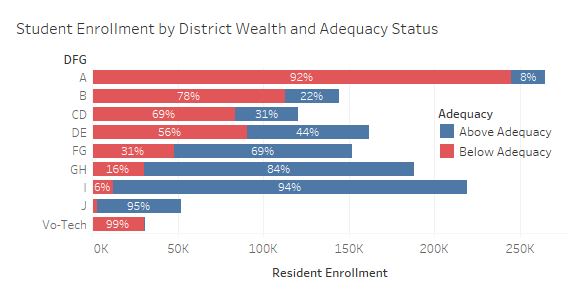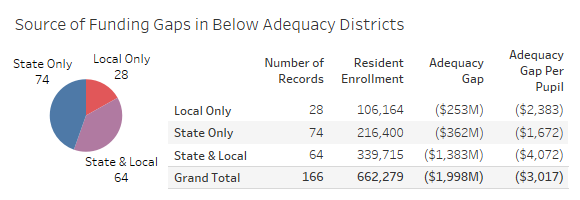AR – NURSES, ESSENTIAL FOR REOPENING NJ SCHOOLS, IN SHORT SUPPLY
Nearly 300 public schools serving over 106,000 students had no assigned school nurse on staff, and another 13,000 students were in schools staffed by a nurse onsite less than full-time, according to an Education Law Center analysis of New Jersey Department of Education (NJDOE) data. The analysis also shows that the lack of nursing staff is most acute in school districts with the largest gaps in spending under the School Funding Reform Act (SFRA), the state’s weighted student funding formula.
These findings are extremely troubling given the NJDOE, in its “Road Back” guidance on reopening schools, underscores the essential role of school nurses in providing for the health and safety, and physical and emotional well-being, of students, teachers and staff. From screening for COVID-19 to isolating those exhibiting symptoms and meeting physical and mental health needs, the guidance puts nurses on the front lines in every school returning to in-person instruction.
“State education officials simply cannot allow any school to reopen that does not have at least one full-time nurse on staff,” said David Sciarra, Education Law Center Executive Director. “Nurses have always been essential in schools and are even more so in the pandemic. The NJDOE must identify the shortage of nurses across the state and launch an emergency initiative to recruit and deploy a full-time nurse in every school before in-person instruction can resume.”
ELC analyzed NJDOE staffing and enrollment data from 2018-19, the most recent data available, using the required student-to-nurse ratio in the SFRA and district spending levels under the SFRA. The SFRA model provides for one nurse for each K-8 school building and one nurse for every 700-800 students in large high schools. Over half of New Jersey’s students are in districts spending below the SFRA’s adequacy target, which means they don’t have enough funds to provide the full complement of staff required for a constitutional, “thorough and efficient” education.
- Nearly all districts raise more local funds than required by the BEP. Districts with the least fiscal capacity raise, on average, $375 per pupil above the level required by the BEP formula, compared to over $2,350 per pupil in districts with the most fiscal capacity.
- On average, the BEP funds one teacher for every 23 students. Wealthier districts supplement with local funds to reduce that ratio to 19-20 students per teacher, while the poorest districts average a student-teacher ratio of 24:1.
- The population of English language learners (ELL) is considerably higher in the poorest districts than in the wealthiest (10% vs. 3%); yet the ELL student to ESL teacher ratio is twice as high in poor districts than in wealthier districts.
New Jersey’s statewide average is one nurse for every 486 students, lower than the nationally recommended, though notably conservative, caseload. But there are glaring inequities in the availability of nurses when analyzed relative to districts’ SFRA spending levels. Those districts with the largest spending deficits – more than $6,000 per pupil below the SFRA’s “adequacy” target – have an average ratio of 785 students per nurse. In contrast, districts spending more than $6,000 per pupil above adequacy have caseloads of one nurse for every 392 students, half that of districts below adequacy.

District-level student-to-staff ratios can mask the number of schools without full-time access to a nurse. Of New Jersey’s 2,500 schools, nearly 300 have no nurse assigned to the building, either full or part-time. Here again, districts with the largest spending deficits under the SFRA formula are most likely to suffer from a nursing shortage. One in five schools in these districts has no nurse, compared to one in ten schools in districts spending above adequacy.

Many charter schools and vocational school districts also report insufficient nursing staff. Twenty-eight of the 88 charter school operators reported no nursing staff, and another 10 have student to nurse ratios above the national standard of 750. Twenty-six of the 69 vocational schools report no nurses, and 9 report student-to-nurse ratios above 750.
This analysis makes clear that, even before the pandemic, New Jersey’s chronically underfunded districts had inadequate nursing staff. The districts with the most severe funding gaps under the SFRA formula are more likely to have higher student-to-nurse ratios and schools with no assigned nurse.
The COVID-19 pandemic shines a bright light on the essential role of nurses to a school’s mission. Research shows nurses improve student attendance and academic success, allow principals and teachers to focus on education instead of student health, and improve immunization rates and vision correction. Nurses serve multiple roles as they attend to daily illnesses, manage students’ long-term health issues, and coordinate medical, dental and mental health services for families. These supports are especially crucial in low-income communities with limited access to healthcare.
“Reopening schools safely depends on adequate nursing staff in every school,” said Danielle Farrie, ELC Research Director. “Schools without nurses will leave students and staff vulnerable to COVID-19, compromising both health and academic success.”
View district level data on school nursing shortages here.
Press Contact:
Sharon Krengel
Policy and Outreach Director
skrengel@edlawcenter.org
973-624-1815, x 24
Press Contact:
Sharon Krengel
Director of Policy, Strategic Partnerships and Communications
skrengel@edlawcenter.org
973-624-1815, x240